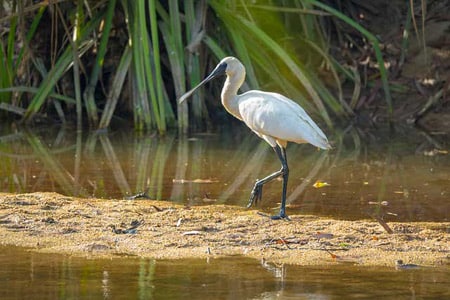On the borders of the Landes and Basque regions, 20 km from the Lou P’tit Poun campsite, the Marais d’Orx offers peaceful summers away from the crowds of tourists and the great beaches of the Seignanx region. A refuge for thousands of migratory birds, it’s one of the few places in Europe where nature has reclaimed its rights from man. Discovery.

From blue to green… a short history of the marsh
Located in Labenne, in the south of the Landes département, the Marais d’Orx is the last major wetland before the Pyrenees. From the Middle Ages to the 19th century, Orx was a feeding marsh exploited by local populations for fishing, hunting and grazing. In particular, leeches were caught and sold to apothecaries. It was Napoleon III who, in 1857, decided to carry out reclamation work to transform the marsh into farmland. A farm was born, and some thirty farms sprang up around the marsh.
Until the 1980s, the Marais d’Orx remained a polder used mainly for agricultural purposes. Hybrid corn is grown here, followed by green beans and sweet corn. In 1989, the Conservatoire du Littoral bought the entire polder and set about renaturalizing the site. Nature gradually reclaims its rights and wildlife is reborn. In 1995, the Domaine d’Orx was classified as a National Nature Reserve, then integrated into the European Natura 2000 network. Today, this 700-hectare protected natural area is home to almost 250 species of wintering and migrating birds. Today, it’s a major ornithological site in the Nouvelle-Aquitaine region, on the West-Atlantic corridor.
Self-guided tour or guided hike to discover the nature reserve behind the scenes
The Marais d’Orx nature reserve can be explored along interpretive trails lined with observatories. But it’s in the company of a naturalist guide, passionate about the place and its history, that you’ll experience a real immersion in the heart of this exceptional site. A half-day guided tour will give you the opportunity to explore the many facets of the marsh, to discover some of its secrets, and to access secret places to observe the flora and fauna. Binoculars are provided for birdwatching outings. Temporary and themed exhibitions are regularly on offer to deepen your knowledge of the marsh. Find out more about guided tours and events programme .
Birdwatching at the Marais d’Orx
Make the most of your
camping in the Landes
to travel on the wings of migratory birds. The marsh’s diversity of environments and habitats (wet meadows, mixed forests, willows, reedbeds, rushes) and the wide availability of food resources, particularly the abundance of fish, attract many migratory and sedentary birds. Nearly 250 bird species have been recorded.
The White Spoonbill, recognizable by its long, spoon-shaped beak, is the emblem of the Marais d’Orx. It’s here, on the borders of the Landes and Basque regions, that the beautiful “Landes wader” comes to rest during its pre-breeding (February to April) and post-breeding (July to October) migrations. The Marais d’Orx is also a preferred migratory stopover for Osprey, Purple Heron, Greylag Goose, White Stilt and Avocet, to name but a few. Hiking in the Marais d’Orx is also an opportunity to observe Cistude turtles, green frogs andEuropean mink (an endangered species), as well as all kinds of butterflies and dragonflies.
The Marais d’Orx by bike
From Labenne, a greenway takes you on foot or by bike to the Maison du marais d’Orx. But don’t forget that cycling in the nature reserve is strictly forbidden! The site can only be visited on foot! Bicycle parking and a picnic area planted with trees are available on the Espace Béziers forecourt, near the Maison du Marais.
Practical information
- Address: 1005 Route du Marais d’Orx, 40530 Labenne
- Open to the public all year round for self-guided tours: approx. 5 km route (2 h to 2 h 30 walk).
- Price of guided tours: €7.50/adult, €3.50/child (half-day, by reservation)
- Bring walking shoes, weather-appropriate clothing, binoculars and spyglass if possible.
- Dogs, even on a leash, are forbidden.
Website : www.reserve-naturelle-marais-orx.fr
